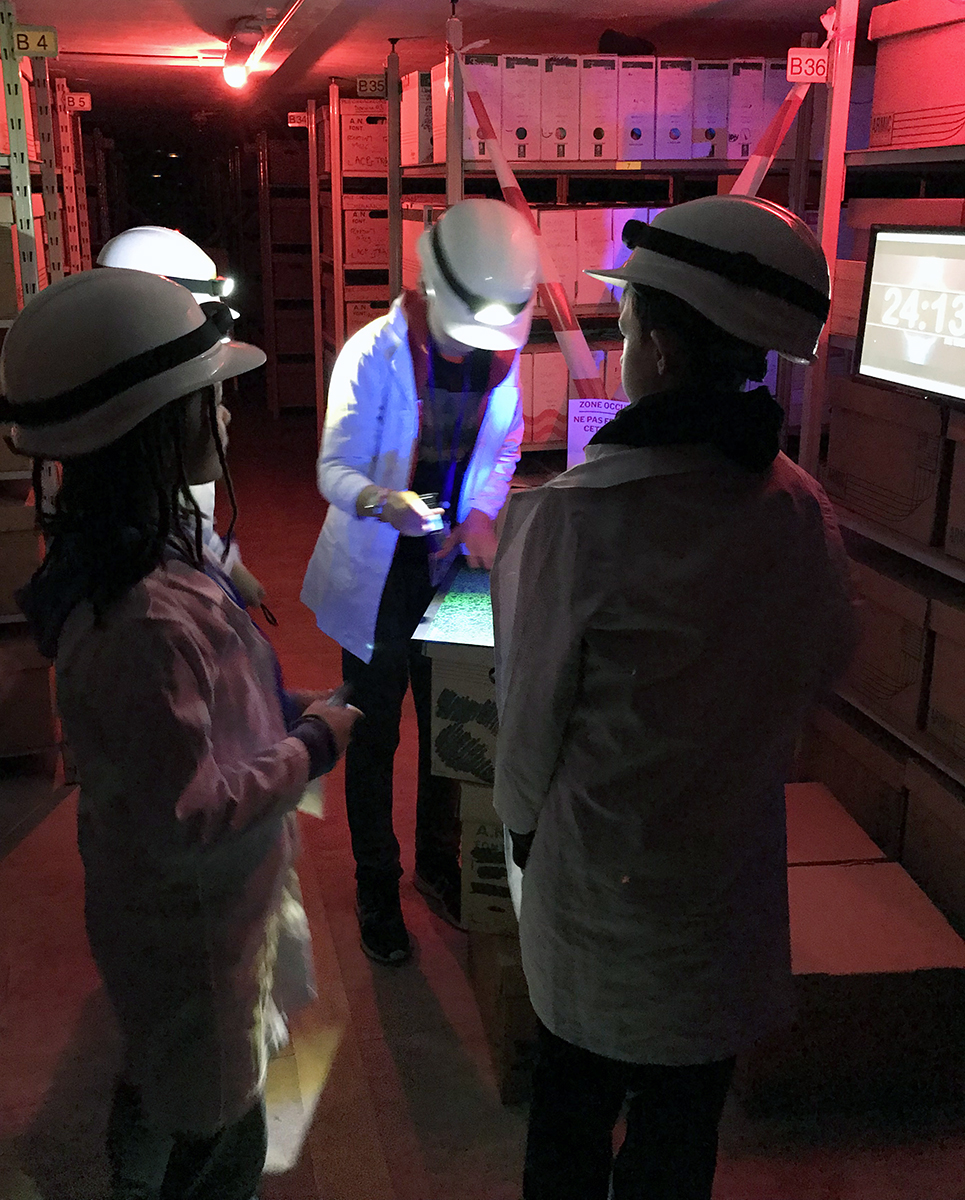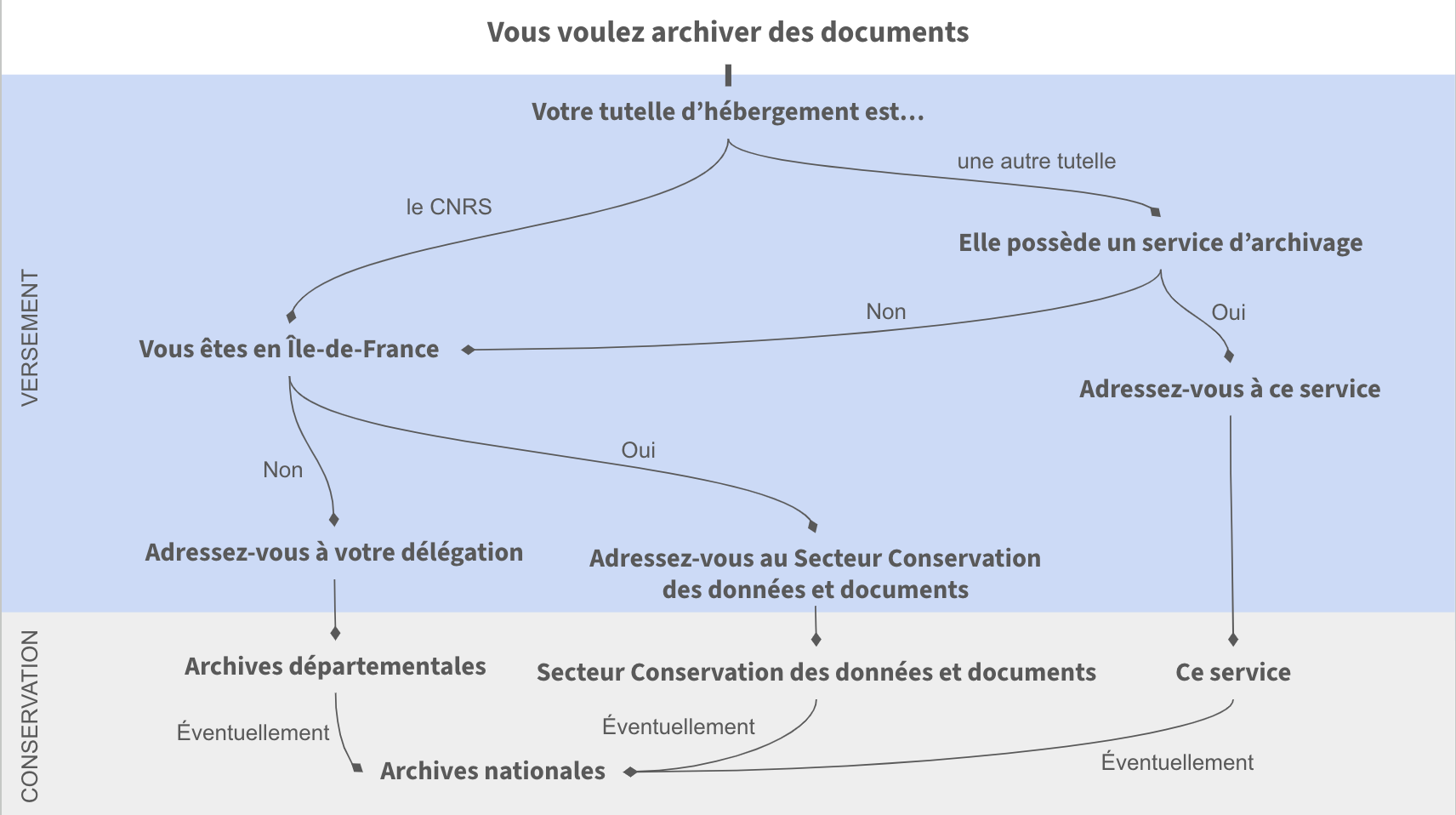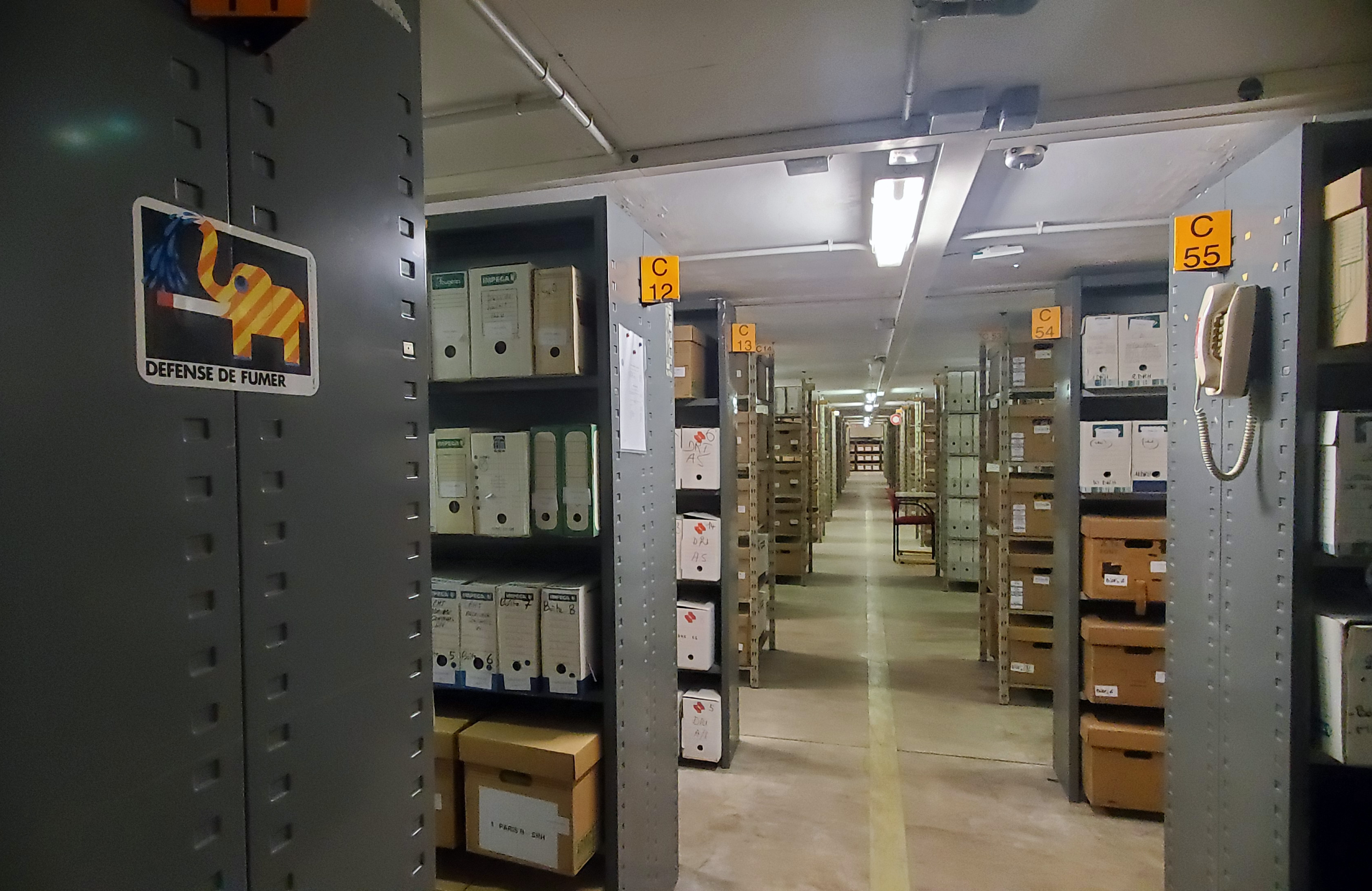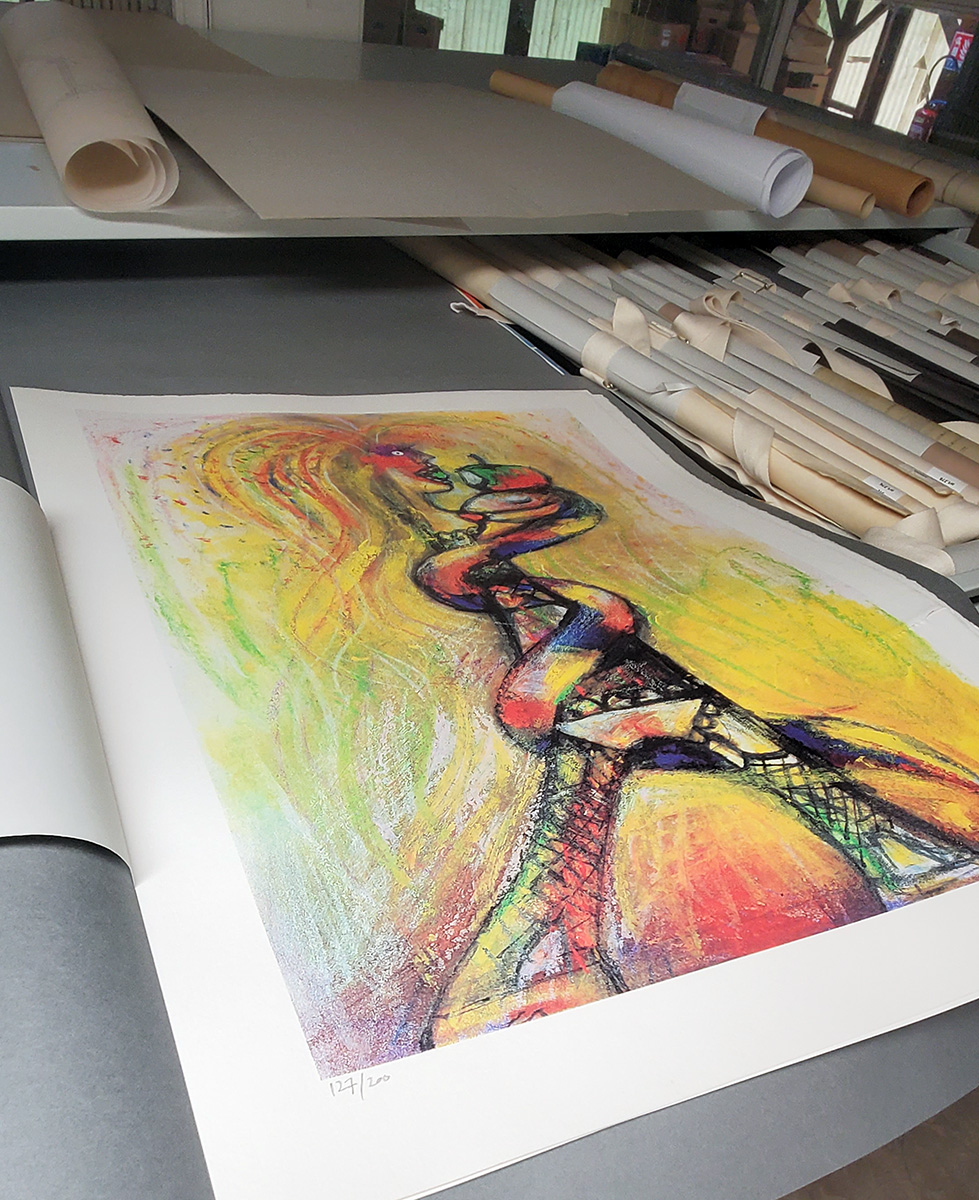The CNRS archives - between preservation and promotion
Did you know it is obligatory for CNRS staff members to preserve their work documents and deposit them in an archive? Let's meet the team that manages these archives for the Île-de-France region.
12 km of archives This may be a surprising figure but it gives a fair idea of the scale of the work involved. If all the documents from the CNRS archives were put end to end and file by file (in the direction of the thickness), that's how long they would be! These archives are in the repository run by the Secteur Conservation des Données et Documents (SC2D) of the shared Île-de-France department1 in Gif-sur-Yvette. So that's 12 km of files sorted, classified, contextualised, annotated and maintained under controlled conditions of temperature, humidity and light on four floors of storage space. Given the quantity of documents, as Isabelle Dujonc, the SC2D's supervisory explains, "you have to be rigorous."
Ms Dujonc and her team of three people are in charge of collecting all CNRS administrative and scientific documents from the CNRS headquarters, the five Île-de-France regional offices and all the associated laboratories. This is a legal obligation because all the working documents of CNRS scientists and administrative staff members2 are considered public archives. "In practice, we mostly manage administrative documents with very few scientific documents. Researchers sometimes find it difficult to keep what could be archived through a lack of awareness or sometimes just give up on their life's work when they retire," explains the archivist Marjolaine Bougenot.
- 1Since 2016, the SC2D (Data and Documents Preservation Unit) has been under the hierarchical authority of the 'Heritage and Logistics' Unit of the Ile-de-France Shared Service (IFSeM). IFSeM in turn is part of the CNRS Ile-de-France Villejuif regional office. In functional terms, the SC2D is linked to the CNRS Legal Affairs Department's own National Data and Document Preservation Unit.
- 2The archives contain documents from all CNRS staff members - from researchers to engineers and technicians.
The files of the main CNRS Offices, career records, activity reports, international cooperation contracts, events created by the CNRS Communications Department – everything is in these administrative archives that show the activity of the CNRS on several scales. "A whole floor, a quarter of the building, is filled with staff career files. It really is a mine of information for the promotion and dissemination of the history of research," enthuses Isabelle Dujonc.
Investigative work and auditing
Archiving requires more than just sorting, tidying and then forgetting. The archives in Gif-sur-Yvette are open to historians, sociologists, students, staff members' families and so forth. Authorisation can sometimes be required for more recent documents (though not for the department that made the deposit) but all the documents become freely accessible after the expiry of certain periods set out in the French Heritage Code. More specifically, career files, any document that could infringe privacy regulations or that contains assessments or value judgements about individuals cannot be accessed for 50 years, even by family members, unless an exemption is granted.1
"Confidentiality is part of our professional ethics," explains Ms Dujonc, with the career files of the CNRS Nobel Prize winners Luc Montagnier and Alain Aspect in mind. These two treasures are yet to be made freely accessible without a prior exemption being granted, as explained above.
To compile these administrative archives, the archivists need to fully understand the workings and activities of each CNRS Office or department and be aware of the legal retention periods applicable to each type of document. Some CNRS regional offices have archiving officers with varying career profiles but the SC2D only employs professionals whose work is regularly checked by experts from the Archives de France and the National Archives2 . A collection officer travels around the Paris regional offices to help their departments decide which documents to preserve and prepare for file transfers. "The archives actually reflect all this know-how and everyone's involvement," explains Isabelle Dujonc.
- 1An exemption may be granted by the department that produced the document and by France's national archives.
- 2The National Archives are housed in a historic Parisian building and a site in Pierrefitte-sur-Seine. They include the documents of the presidency of the French Republic, Ministries, administrative departments and State establishments. The latter of course includes the CNRS's historical archives. The Archives de France carries out the scientific and technical supervision of archive management at the CNRS.
"Classifying archives of historical interest is the core of our profession, even if we don't have enough time to devote to it," she adds. For example, the unit is currently classifying and digitising cassettes of interviews with the late historian and sociologist Olivier Kourchid, a CNRS research professor who passed away in 2018 and is particularly renowned for his work on the miners of northern France. "We try not to spend too long looking into the files but sometimes it's just too fascinating," admits Marjolaine Bougenot.
Science too!
For these scientific archives to be made available to the public, the archivists first need to decipher and understand the main issues and subjects dealt with on every page. This includes documents in other languages and hastily-written laboratory notebooks. The SC2D receives a wide range of documents which means a varied expertise is required of its staff members. "The most important thing is to put things into context in a neutral and factual way, without making an interpretation", explains the assistant engineer.
This can sometimes lead to "beautiful encounters". One came when the children of the astronomer Janine Connes cleared out their mother's desk and gave all her precious files to the archives of the organisation that asked her to direct the first French computing centre (the forerunner of the IDRIS) way back in 1969. Or when the grandson of Jean Perrin, the founder of the CNRS, contributed documentation for an escape game organised by the team (see box).
The audiovisual collection was also enriched in recent years through a collaboration set up with CNRS Images in 2022 when the organisation's Meudon site was reorganised. The oldest films are sent to the National Archives but some historic posters are conserved at Gif-sur-Yvette along with certain plans that are stored flat in large-format plan cabinets. "Collections in the form of photos remain rare and are very moving", smiles Marjolaine Bougenot as she remembers the traces of the ethnologist Germaine Tillion's desert expeditions found in her career file. Ms. Tillion is now in the Panthéon.
The team hopes to find photos in the additional 1.8 km of archives it is currently recovering from the Meudon regional office and also from the regional office for HSS laboratories in Ivry. "There's a lot of logistics involved, especially as we're in a building that's already reaching saturation point. Our equipment could do with a proverbial lick of paint but it really is essential to safeguard these documents," says Isabelle Dujonc. "And we might even find some cool surprises!" See you when the sorting's finished.
Introducing young people to the archives

The SC2D team also organised an escape game for local schoolchildren to mark the 80th anniversary of the CNRS at the end of 2019. The game was based on Jean Perrin, the founder of the CNRS in 1939. The aim for those playing was to find the legal decree officialising the creation of the CNRS which had been hidden in case of a German invasion. "It was a new experience," says Marjolaine Bougenot. "We wanted to propose something a bit more colourful than an exhibition of 'old documents' and our building suits that kind of thing well." 450 primary schoolchildren took part in the game over a two-month period, playing in the dark and in an atmosphere of bombing. Is it worth repeating? Isabelle Dujonc admits that "there are major safety and time constraints. But this sort of initiative is a good way of getting people talking about archives and raising awareness of how important they are. We'd like to be able to run them more often!"



